The Texas Library Association Annual Conference is next week! Will you be there? If so, we’d love to meet you. Here is our exciting signing schedule below:
 Wednesday, April 15
Wednesday, April 15
Thursday, April 16
We’ll be at Booth 2051 and look forward to meeting you!
 Andrea Cheng is the author of several critically-acclaimed books for young readers. Her most
Andrea Cheng is the author of several critically-acclaimed books for young readers. Her most  recent novel, Etched in Clay, tells the story in verse of Dave the Potter, an enslaved man, poet, and master craftsperson whose jars (many of which are inscribed with his poetry and writings) are among the most sought-after pieces of Edgefield pottery. Etched in Clay recently won the Lee Bennett Hopkins Poetry Award.
recent novel, Etched in Clay, tells the story in verse of Dave the Potter, an enslaved man, poet, and master craftsperson whose jars (many of which are inscribed with his poetry and writings) are among the most sought-after pieces of Edgefield pottery. Etched in Clay recently won the Lee Bennett Hopkins Poetry Award.
April is National Poetry Month, so we asked author Andrea Cheng to share one of her favorite poems from Etched in Clay:
FEATURED POEM
Etched in Clay, p. 65
A Poem!
Dave, July 12, 1834
The summer’s so hot,
it’s like we’re living
in the furnace.
The clay doesn’t like it either,
getting hard on me
too quick.
I better hurry now,
before the sun’s too low to see.
What words will I scrawl
across the shoulder
of this jar?
I hear Lydia’s voice in my head.
Be careful, Dave.
Those words in clay
can get you killed.
But I will die of silence
if I keep my words inside me
any longer.
Doctor Landrum used to say
it’s best to write a poem a day,
for it calms the body
and the soul
to shape those words.
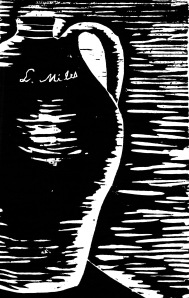
This jar is a beauty,
big and wide,
fourteen gallons
I know it will hold.
I have the words now,
and my stick is sharp.
I write:
put every bit all between
surely this jar will hold 14.
Andrea Cheng: There are three poems in Etched in Clay which speak directly about the act of writing. In the first one, “Tell the World,” (EIC p. 38) Dave writes in clay for the first time. Using a sharp stick, he carves the date, April 18, into a brick; he is announcing to the world that on this day, “a man started practicing/his letters.” In the poem called “Words and Verses,” (EIC p. 52) Dave thinks about writing down one of the poems that has been swirling around in his head as he works on the potter’s wheel. Finally, in “A Poem!” (EIC p. 67) Dave actually carves a couplet into one of his jars. His words are practical and ordinary; he simply comments on the size of the jar. But he is no longer silent.
Further Reading:
Andrea Cheng on Writing Biography in Verse
An interview with Andrea Cheng about Etched in Clay in School Library Journal
A look at how Andrea Cheng made the woodcut illustrations for Etched in Clay
Filed under:
guest blogger,
Holidays,
Musings & Ponderings Tagged:
Andrea Cheng,
dave the potter,
david drake,
Etched in Clay,
National Poetry Month,
poems,
poetry,
poetry Friday,
pottery,
slavery 


Andrea Cheng is the author of several critically-acclaimed books for young readers. Her most  recent novel, Etched in Clay, tells the story in verse of Dave the Potter, an enslaved man, poet, and master craftsperson whose jars (many of which are inscribed with his poetry and writings) are among the most sought-after pieces of Edgefield pottery. Etched in Clay recently won the Lee Bennett Hopkins Poetry Award.
recent novel, Etched in Clay, tells the story in verse of Dave the Potter, an enslaved man, poet, and master craftsperson whose jars (many of which are inscribed with his poetry and writings) are among the most sought-after pieces of Edgefield pottery. Etched in Clay recently won the Lee Bennett Hopkins Poetry Award.
When I heard an NPR review of Leonard Todd’s book, Carolina Clay, I knew that Dave’s was a story I wanted to  tell. And from the start, I knew that I wanted to tell it in verse. Readers often ask me why. I didn’t make this decision consciously, but subconsciously, I think there were reasons.
tell. And from the start, I knew that I wanted to tell it in verse. Readers often ask me why. I didn’t make this decision consciously, but subconsciously, I think there were reasons.
The evidence of Dave’s life is fragmentary: pots and shards and bills of sale. This means that each small piece of evidence stands for something more, something much larger than the object itself. For example, the first bill of sale shows that Harvey Drake purchased a teenage boy for six hundred dollars. He was “country born” with “good teeth” and “a straight back. “ (Etched in Clay, p. 7) There is so much sorrow in these few words. A person is being evaluated and then sold like an animal. After a quick transaction, he becomes the property of someone else. The only way I know to allow a reader to feel this sorrow is through the intensity of a poem.
And of course, Dave was a poet, so it seems fitting to tell his life in verse. Sometimes he had fun with words and puns and tongue twisters like mag-nan-i-mous and se-ver-it-y. Other times he expressed the sorrow of his life in cryptic couplets:
I wonder where is all my relation
friendship to all—and every nation.
Poetry is intense and versatile. Each word and each phrase is loaded and can hold multiple meanings. This is the way that Dave wrote, and it is the only way that I could attempt to represent his life.
The other question people often ask is why I chose to tell the story in multiple voices.
The first poems I wrote were from Dave’s point of view. I started with:
Another Name
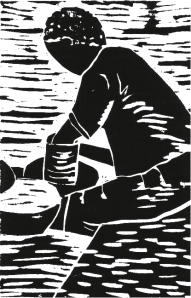
Illustration from Etched in Clay
Dave, 1815
Master says ”Dave—
That suits you.
That’s your name.”
He can call me
Whatever he pleases,
Tom or John or Will or Dave,
No matter.
I had another name once.
I can’t remember the sound of it;
But I know the voice,
smooth and soft,
that whispered it
close to my ear
in the still night.
And then
my mother was gone.
After writing several poems in Dave’s voice, I wanted to explore the other people in Dave’s life. What did they say? How did they feel? How did they relate to Dave? What about Harvey Drake, a young man sent by his uncle to purchase a slave? Was he confident in making this purchase? Did he have doubts? What about Eliza, a house slave thought to be Dave’s first wife? I cannot imagine the sorrow of their separation when she was sold and taken to Alabama. I wanted to hear from Dave’s subsequent owners: Abner Landrum, John Landrum, Reuben Drake, Lewis Miles, and BF Landrum. Lewis Miles and Dave seemed to have become friends of sorts, even joking about the way to place a handle on a clay pot. And then there was the despicable Benjamin Franklin Landrum who says “It takes a strong whip/to control these slaves.” (EIC p. 101.) After a terrible beating, Dave finds one of the slaves “…hanging limp/and her pulse is gone.”
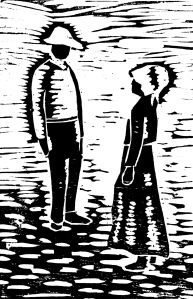
Illustration from Etched in Clay
Multiple voices can allow the readers a glimpse into the minds of various characters. Why do they do what they do? How do they rationalize their actions to themselves and others? How do they relate to other characters? With multiple voices, the writer can create a world.
While doing the research for Etched in Clay, I read articles about Dave’s pottery and viewed photographs of his jugs. I read about the history of South Carolina and the Landrum Family that owned Dave through much of his life. I read hundreds of slave narratives. And then I drove 11 hours from Ohio to South Carolina.
While traipsing across the Carolina fields where Dave once lived and worked, it started drizzling. After a short storm, the sun came out, and I saw that the field was littered with shards of pottery, glistening in the morning light. I picked up a few shards and wondered if perhaps they were Dave’s. Then I walked downhill to the creek where Dave and others dug the clay. The water was cold and running fast. The banks were steep. I held a handful of wet clay in my hand. In the evening, at the Edgefield Inn, near Dave’s home, I wrote many of the poems in Etched in Clay. Like the shards I had seen, I hope that they create a whole.
Further Reading:
An interview with Andrea Cheng about Etched in Clay in School Library Journal
A look at how Andrea Cheng made the woodcut illustrations for Etched in Clay
Filed under:
Curriculum Corner Tagged:
Etched in Clay,
National Poetry Month,
Nonfiction poetry,
poetry,
teaching resources,
writing,
writing resources 

 Jaclyn DeForge, our Resident Literacy Expert, began her career teaching first and second grade in the South Bronx, and went on to become a literacy coach and earn her Masters of Science in Teaching. In her column she offers teaching and literacy tips for educators.
Jaclyn DeForge, our Resident Literacy Expert, began her career teaching first and second grade in the South Bronx, and went on to become a literacy coach and earn her Masters of Science in Teaching. In her column she offers teaching and literacy tips for educators.
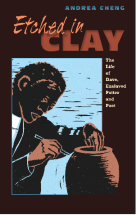 Over the past several weeks, I’ve been modeling how to do a close reading at several different grade levels. Next up: Close Reading in Fourth Grade using the T level text Etched in Clay: The Life of Dave, Enslaved Potter and Poet written and illustrated by Andrea Cheng, out this January!
Over the past several weeks, I’ve been modeling how to do a close reading at several different grade levels. Next up: Close Reading in Fourth Grade using the T level text Etched in Clay: The Life of Dave, Enslaved Potter and Poet written and illustrated by Andrea Cheng, out this January!
One way to structure close reading questioning is to use the format laid out by the Institute for Learning of the University of Pittsburgh. Under their framework, students read the text selection four times: first, to get the gist; second, to find significant moments or ideas; third, to interpret the ideas in the text; and finally, to analyze the author’s methods (craft). Here’s an example of how to plan out your questions for close reading of the introduction through the first 13 pages of Etched in Clay:
1st reading (read to get the gist):
- Who is Dr. Abner Landrum? What have we learned about him? What can we infer about him so far? Cite evidence from the text to support your answer.
- Who is Harvey Drake? What have we learned about him? What can we infer about him so far? Who is Amos Landrum? How is Harvey different than Amos? Cite evidence from the text to support your answer.
- Who is Dave? What have we learned about him? What can we infer about him so far? How does he feel about the work he’s been given to do? About being renamed “Dave”? About his first pottery lesson? Cite evidence from the text to support your answer.
- What major events have occurred so far? How much time has passed? During what period in history are the events taking place? How do you know? What do you know about this period in American history that can help your reading of the text? Cite evidence from the text to support your answer.
- What was important to Dr. Abner Landrum? Cite evidence from the text to support your answer.
2nd reading (read to find significant moments or ideas):
- What is the most important thing you learned or that happened in this section of the text? Why is it significant? Cite evidence from the text to support your answer.
3rd reading (read to interpret ideas):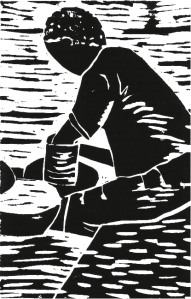
- In the poem “Augusta Auction”, how does the auctioneer view Dave? How does Harvey Drake view Dave? What can you infer about how Harvey Drake feels about slavery? Cite evidence from the text to support your answer.
- On page 7 in the poem “Augusta Auction,” Harvey Drake describes the slaves at auction as follows: “The Negro mothers wail/while their children cling to them/like melons to their vines.” Cheng’s passage serves two purposes, one descriptive and one historical/sociological. Discuss the dual meanings of the image she creates. Cite evidence from the text to support your answer.
4th reading (read to analyze the author’s methods/craft):
- How is this text organized? How is it different than other biographical texts or historical fiction you’ve read? How is it similar? Cite evidence from the text to support your answer.
- Who is the audience for this text? Why does Andrea Cheng consistently shift narrator? What effect does this have on how the story is told and how the information is presented? Cite evidence from the text to support your answer.
- What are some of the strongest images Cheng has created so far? How do these images set the mood for the piece? Cite evidence from the text to support your answer.
By asking students to ground their responses in the text by citing text-based support for their answers, the following Common Core Standard is addressed:
Reading Literature, Grade 4, Key Ideas and Details, Strand 1: Refer to details and examples in a text when explaining what the text says explicitly and when drawing inferences from the text.
How does close reading look in your classroom? Any tricks and tips to share?
Further reading:
Filed under:
Curriculum Corner,
Resources Tagged:
Andrea Cheng,
close reading,
common core standards,
Etched in Clay,
guided reading,
History,
Reading Aloud,
reading comprehension,
slow reading 

One of our upcoming books that I’m most excited about is a new middle grade novel in verse called Etched in Clay, out this January. Etched in Clay, by Andrea Cheng, explores the life of Dave the Potter, an enslaved man from South Carolina who learned how to read and write. Dave is famous for inscribing his own poetry and thoughts on the pottery that he made – a very daring thing in light of the harsh anti-literacy laws for slaves in place at the time.
Author and artist Andrea Cheng used woodcuts to create the delicate spot art for Etched in Clay. Here’s how she did them:
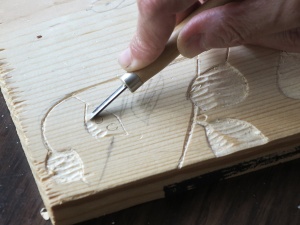
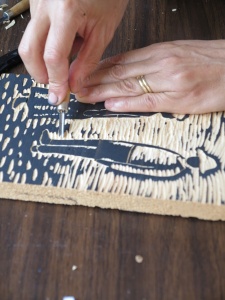
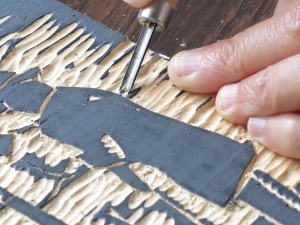

“After carving the wood blocks, I roll them with ink…
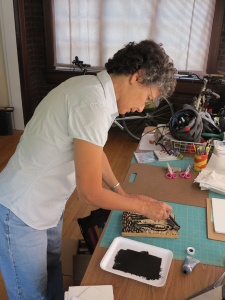
…and print them by placing paper on top of the block…
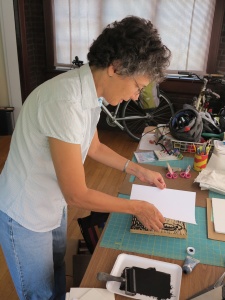
…rubbing it…
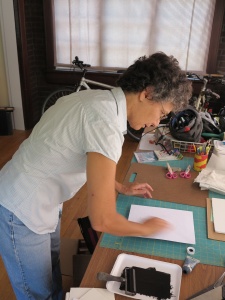
…and then pulling the print off the block.
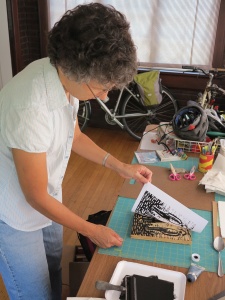
I usually print several times because each print is different, and I’m trying to get one that is evenly inked.
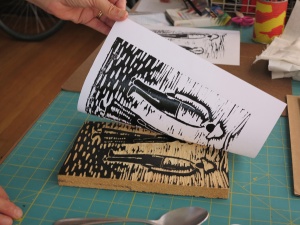
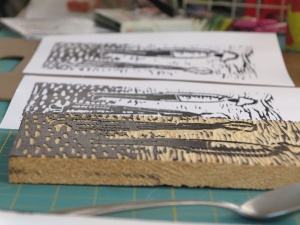
Then, when I have a couple of good prints, I ‘clean’ the block by printing with scrap paper (green tissue in picture). I sometimes use these light prints for collages or other artwork.”
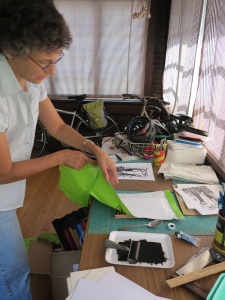
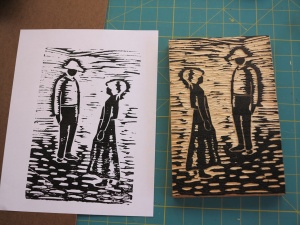
Here’s what the final image looks like in the book:

Kirkus Reviews has just given Etched in Clay its first starred review, calling it “at once intimate and universal; the riveting story of an unforgettable life lived during an unbelievable time.” Learn more about the book, or like us on Facebook to see more pictures of Andrea’s illustrations.
Want to see more artwork in progress? Illustrator Beth Lo shares how to paint a ceramic plate.
Filed under:
Art Tagged:
African/African American Interest,
Etched in Clay,
illustration,
sneak peeks 

























Andrea, this book is exquisite and moving. I agree that there’s nothing like poetry to address the intensity of life. Your woodcuts are also fabulous. Congratulations on a stunning book!
[…] Looking Past the Cover • Children's Book Publishing • Diversity and Race • Conversation « Andrea Cheng on Writing Biography in Verse […]